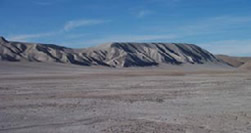Hydrothermal Activity in an Impact Crater
by Gordon "Oz" Osinski


Bruno Escarpment - The pale grey impact-produced breccias provided the heat source for the hydrothermal activity at Haughton.
 |
|
It is now widely
recognized that impact
cratering is a ubiquitous
process that affects all the
terrestrial planets. The surface
of the Moon, where other
geological processes stopped
billions of years ago, records
this process clearly. On Earth,
however, impact craters are continually erased by erosion,
volcanism and tectonic activity. Thus, despite the fact that
the Earth has been more heavily bombarded than the Moon,
only about 160 terrestrial impact craters have been recognized
to date, although several new structures are found each year.
So why is the study of the impact hazard important? Well,
we hope to learn what has impacted our planet in the past,
and what effects these past impacts had on the structure of
the Earth, its atmosphere, and its biosphere. Indeed,
it is now accepted that a large impact event about
65 million years ago on Mexico’s Yucatan
Peninsula redirected biological evolution on Earth.
This event formed a crater approximately 180 km
in diameter and resulted in the extinction of about
75% of life on Earth, including the Dinosaurs.


The beautiful Lake Sapphire stands out as a modern day oasis. Hydrothermal vents on the lake floor may have provided warm, wet sites for the re-establishment of life.
 |
|
It is well known that hydrothermal systems
will develop anywhere in the Earth’s crust where
water coexists with a heat source. It may also be
possible that hydrothermal systems provided a
warm, wet site for the origin of life on Earth and other
planets (e.g., Mars). During
the last two summers in the
Canadian Arctic, we have
found evidence for the
existence of a hydrothermal
system formed by the
interaction of hot, impact-generated
rocks with
groundwaters at the 24 km-diameter,
23 million year old
Haughton impact structure
on Devon Island. From comparisons with other impact
craters and from certain thermal considerations, it may
have taken as long as tens of thousands of years for the
land to cool below 50°C following the impact. During
this time, Haughton would have represented a warmer,
wetter environmental niche relative to the surrounding
devastated terrain. There is then, the possibility of life
after death!
|

